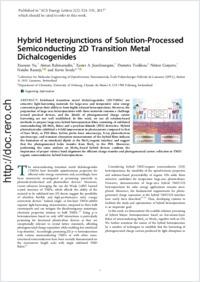Hybrid heterojunctions of solution-processed semiconducting 2d transition metal dichalcogenides
- Yu, Xiaoyun Laboratory for Molecular Engineering of Optoelectronic Nanomaterials, École Polytechnique Fédérale de Lausanne (EPFL), Switzerland
- Rahmanudin, Aiman Laboratory for Molecular Engineering of Optoelectronic Nanomaterials, École Polytechnique Fédérale de Lausanne (EPFL), Switzerland
- Jeanbourquin, Xavier A. Laboratory for Molecular Engineering of Optoelectronic Nanomaterials, École Polytechnique Fédérale de Lausanne (EPFL), Switzerland
- Tsokkou, Demetra Department of Chemistry, University of Fribourg, Switzerland
- Guijarro, Néstor Laboratory for Molecular Engineering of Optoelectronic Nanomaterials, École Polytechnique Fédérale de Lausanne (EPFL), Switzerland
- Banerji, Natalie Department of Chemistry, University of Fribourg, Switzerland
- Sivula, Kevin Laboratory for Molecular Engineering of Optoelectronic Nanomaterials, École Polytechnique Fédérale de Lausanne (EPFL), Switzerland
-
10.02.2017
Published in:
- ACS Energy Letters. - 2017, vol. 2, no. 2, p. 524–531
English
Exfoliated transition metal dichalcogenides (2D-TMDs) are attractive light-harvesting materials for large-area and inexpensive solar energy conversion given their ability to form highly tolerant heterojunctions. However, the preparation of large-area heterojunctions with these materials remains a challenge toward practical devices, and the details of photogenerated charge carrier harvesting are not well established. In this work, we use all solution-based methods to prepare large-area hybrid heterojunction films consisting of exfoliated semiconducting 2H-MoS2 flakes and a perylene-diimide (PDI) derivative. Hybrid photoelectrodes exhibited a 6-fold improvement in photocurrent compared to that of bare MoS2 or PDI films. Kelvin probe force microscopy, X-ray photoelectron spectroscopy, and transient absorption measurements of the hybrid films indicate the formation of an interfacial dipole at the MoS2/organic interface and suggest that the photogenerated holes transfer from MoS2 to the PDI. Moreover, performing the same analysis on MoSe2-based hybrid devices confirms the importance of proper valence band alignment for efficient charge transfer and photogenerated carrier collection in TMD/organic semiconductor hybrid heterojunctions.
- Faculty
- Faculté des sciences et de médecine
- Department
- Département de Chimie
- Language
-
- English
- Classification
- Chemistry
- License
-
License undefined
- Identifiers
-
- RERO DOC 288571
- DOI 10.1021/acsenergylett.6b00707
- Persistent URL
- https://folia.unifr.ch/unifr/documents/305448
Other files
Statistics
Document views: 101
File downloads:
- pdf: 175
- Supplementary material: 169

